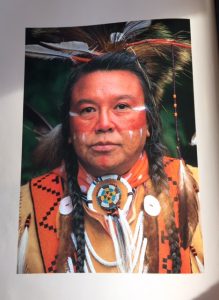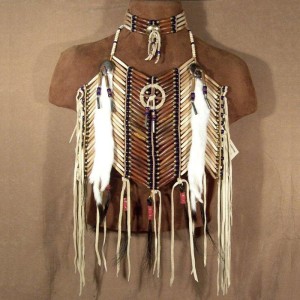History of Native American Jewellery
I started by photocopying an image of a Native American man I came across in a book titled Tribes by Art Wolfe. Wolfe is an acclaimed American photographer and conservationist whose colourful photographs of wildlife, native tribes and landscapes have been documented in books and television series.
Tribes has over 120 portraits that captures 35 indigenous tribes from New Guinea, Africa and American Southwest.
The image is of a man from the Kalispel tribe that I captioned; ‘A Native American male from Kalispel tribe donned in tribal jewellery’.
I was fascinated by his elaborate native neck-piece which inspired me to search for images of Native American jewellery. I came across an image of a piece from http://www.lostrivertc.com/product/medicine-wheel-breastplate-matching-choker/ that deals in Native American jewellery. This piece was listed as a medicine wheel breast plate and matching choker. It is a combination of medicine wheel, brass conchos, brass and cobalt blue glass beads, horse hair, ermine skins with tails, bone beads in cones and red felt. This native piece of jewellery is made using smoked coloured deerskin which are on the fringe and tail.
From there I decided to look deeper into the history of Native American jewellery to what it is in today’s contemporary world. It is believed that the Native American people were crafting jewellery before the 1880s when the Europeans settled in America. They created buttons, brooches and bridles worn during ceremonies rather than for fashion as it is today.
In the 1850s, a blacksmith Atsidi Sani from Navajo which is the largest Native American tribe, started incorporating metal in jewellery designs which they used as a currency when trading with European settlers. The Spanish introduced silver in 1865 and Sani learnt the craft of adding silver mainly by stamping on Native American ornaments, a skill taken from the Mexican workers. Sani taught his 4 sons this skill in 1890 and in time became a professional silversmith. A J.L Hubbell hired Mexican workers to teach this craft to several Native Americans from Navajo. They later acquired the art of combining turquoise in their designs and this became more popular as more mines were opened. Atsis Chon was the first Navajo to include turquoise on a silver piece. The Zuni tribe later on combined their style of jewellery designing with the Navajo as better tools and techniques became available in the twentieth century.
Native American jewellery became commercialised in the 1910s and 1920s when native traders and railroad vendors like Fred Harvey Company started buying it and later selling it to European settlers and tourists.
To this day the Native American community still make authentic jewellery and sell it to support their families.
The history of Native Americans and their ornaments can be found in museums like American Museum in Britain (Bath), Natural History Museum (Birmingham), National Museum Liverpool and British Museum.
Bibliography;
-Tribes by Art Wolfe page 116
-Documentary television series- Travels to the Edge with Art Wolfe
http://www.lostrivertc.com/product/medicine-wheel-breastplate-matching-choker/
http://americanindianoriginals.com/jewelry-making2.html https://americanmuseum.org/
www.liverpoolmuseums.org.uk/wml/collections/ethnology/americas.aspx
www.britishmuseum.org/explore/themes/native_north_america.aspx
http://www.alltribes.com/kcenter/jewelry-information/jewerly-history.html


